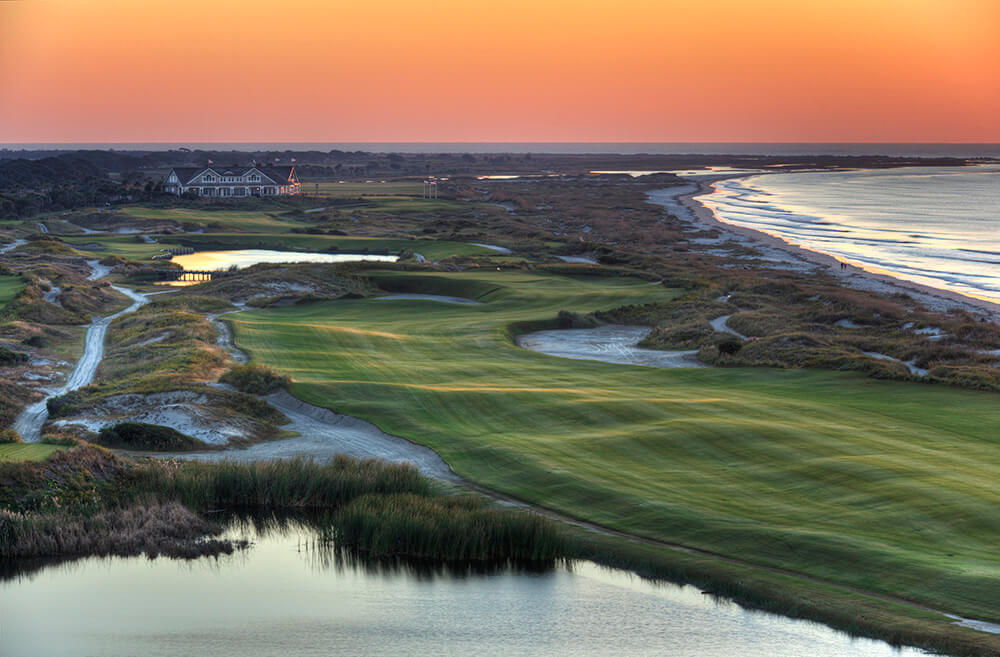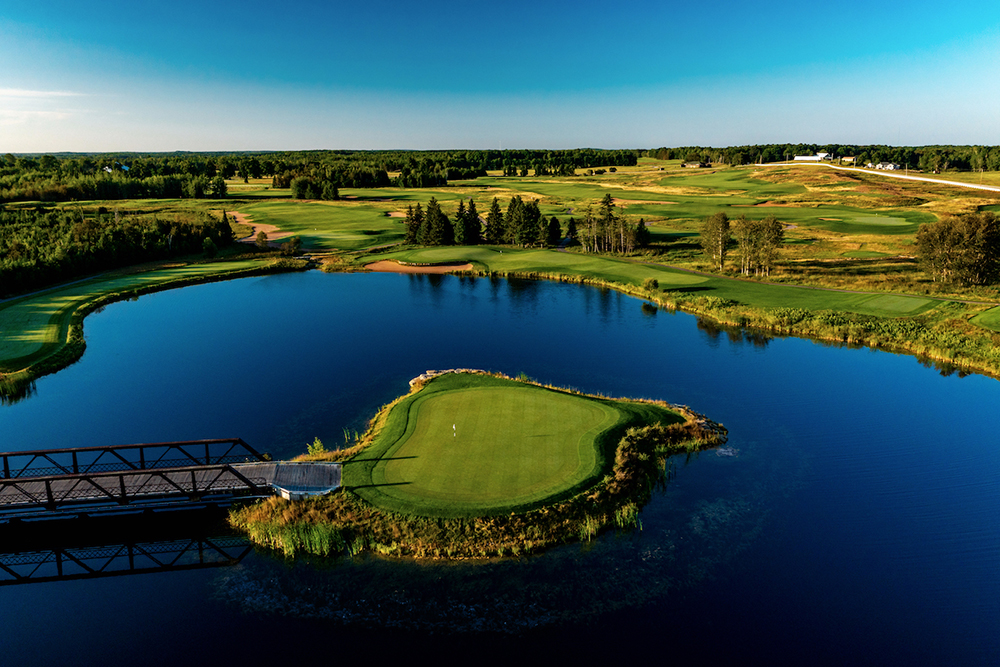“No man is an island,” wrote English poet John Donne in 1624. That may be, but 400 years later, we sure enjoy playing them. There are plenty of spectacular islands of golf—Australia, Ireland, Hawaii, and Hilton Head, to name a few—but not as many must-play courses that feature the word “island” in its name.
Here are the top 10 “island” golf courses in the U.S. at which anyone can play—with one glorious exception.
Fishers Island Club—Fishers Island, N.Y.
The glorious exception to the public-access “island” courses on our list is this extremely private enclave in the Northeast. Accessible only by air or ferry, Fishers Island off the Connecticut coast is a low-key, Golden Age Seth Raynor design with classic template holes and eye-popping vistas throughout. “The first time you play it, you can’t appreciate it architecturally,” said architect Gil Hanse in 2019. “There’s too much beauty to take in, too many water views—the Atlantic Ocean, Fishers Island Sound, and tidal marsh all frame what you see.”

Kiawah Island Golf Resort (The Ocean Course)—Kiawah Island, S.C.
A blend of wind-whipped tidal marsh carries, scrub-topped dunes, and undulating greens pair with 7,876 muscular yards to form The Ocean Course’s relentless mix of gorgeous scenery and gargantuan challenge. While architect Pete Dye softened his greens and their surrounds over the years, The Ocean Course remains among the toughest tests in the country. A beguiling mix of brutish par fours pairs with Atlantic Ocean scenery to test resort guests as well as the game’s elite at such events as the 1991 Ryder Cup and the 2012 and 2021 PGA Championships. Kiawah Island Golf Resort’s four other championship offerings, led by Tom Fazio’s Osprey Point, are legitimate contenders for any list of best “island” courses.

Sea Island (Seaside)—St. Simons Island, Ga.
Seaside at Sea Island Resort soared from a 1999 Tom Fazio makeover that combined a 9-hole, Colt/Alison-designed Golden Age classic and a less distinguished nine from the ’70s into a formidable track that has played host to the PGA Tour’s RSM Classic since 2010. Huge bunkers, low dunes, marsh-tinged wetlands, firm fairways, and several Atlantic Ocean views lend an Old World, linksy feel, especially when the breezes blow. At 7,005 yards, par 70, Seaside isn’t brutishly long by modern standards, but combine wind and marsh carries, and it can play plenty tough.

Lakes of Isles (North)—North Stonington, Conn.
The Mashantucket Pequots pioneered the tribal casino-resort with their prosperous Foxwoods in southeastern Connecticut, yet it wasn’t until 2005 that they had a course worth bragging about. Rees Jones chiseled two formidable spreads from the rock-studded hills, the North and the South. Only the North is open to outside play, and with its dramatic visuals, especially of the 90-acre namesake lake, it’s all the golf and scenery you could want. Wetlands, rock ledges, and rolling, forested terrain form compelling elements in a spectacular, unyielding design.

Turnberry Isle (Soffer)—Aventura, Fla.
Surrounded by high-rises and drenched with lakes, this boldly bunkered, rugged 2006 Raymond Floyd redesign just north of Miami is best known for its par-five 18th hole, with its peninsula green backdropped by a waterfall. Creeks, lagoons, and mature trees add further menace and beauty to the 7,047-yard, par-71 layout that boasts a nosebleed slope rating of 149 from the tips. Guests of the JW Marriott Miami Turnberry Resort & Spa may play this private club.

Bald Head Island Club—Bald Head Island, N.C.
You must jump through a few hoops to score a tee time here—starting with a ferry ride over from nearby Southport, N.C.—but it’s worth the effort to play this 1974 George Cobb design that was renovated with a major makeover in 2010 by Tim Cate. Exposed sand features and expansive water hazards predominate, notably at the layout’s most dramatic par threes, the 173-yard 8th and the 187-yard 16th. Weekday afternoons offer the best chance of availability for registered guests of a Bald Head Island vacation rental home.

Island Resort & Casino (Sweetgrass)—Harris, Mich.
Equal parts heartland, Scotland, and Tribal tradition, Island Resort’s Sweetgrass is a 2008 Paul Albanese design on Michigan’s Upper Peninsula. The low-profile, linksy design stretches 7,275 yards from the back Black tees, with a sturdy 143 slope. The native fescues add to the Old-World feel, though multiple ponds being you back to reality that you’re in Michigan, not Machrihanish. Albanese conjured up a fistful of template greens for the layout, including a Redan, a Biarritz, a double green, and an island green at the 168-yard par-three 15th, though many of putting surfaces are propped up, putting a premium on precise approaches.

Innisbrook Resort (Island)—Palm Harbor, Fla.
The older sibling to Innisbrook’s Copperhead course, a longtime PGA Tour venue, the Island has some nifty tournament history of its own. In 1990, it played host to the NCAA Men’s Division I Golf Championship, and the individual title that year went to Arizona State Sun Devil sophomore Phil Mickelson. E.L. “Larry” Packard carved out the Island in 1970 and at 7,194 yards, par 72, with a 75.5 rating and a 142 slope, it’s the virtual equal to Copperhead in difficulty. Lakes are in play on 10 holes and if the water doesn’t snare you, it’s likely one of the 74 bunkers will.

Amelia Island Resort (Oak Marsh)—Amelia Island, Fla.
An early effort from Pete Dye, circa 1972, aptly named Oak Marsh reminded some of his work up the coast at Harbour Town. Oak Marsh was short, in the 6,500-yard range, and featured tight fairways framed by moss-draped oaks, small, bulkheaded greens, the aforementioned marshes, and variety in the sizes and shapes of bunkers. Currently, Oak Marsh is in the last stages of a Beau Welling refresh. New wall-to-wall turf and irrigation will enhance playability and conditioning, expanded teeing grounds will bump up flexibility and renovated bunkers, with some repositioned, will boost the strategic challenge for the current crop of golfers.

Fripp Island Golf & Beach Resort (Ocean Point)—Fripp Island, S.C.
With two excellent courses, Ocean Point, a 1964 George Cobb design, and Ocean Creek, a 1995 creation from Davis Love III’s Love Golf Design, it’s a coin flip to choose one over the other. The pick here is for Ocean Point, which just concluded a well-received renovation by Cynthia Dye McGarey, Pete’s niece, in tandem with her son, Matt McGarey. Atlantic Ocean encounters at the par-four 9th and par-five 18th remain true highlights, but the changes have elevated the rest of the look and playability of the layout. The designers reshaped more than 50 bunkers and added 11 greenside bunkers. Other additions included several new fairway bunkers and tee boxes, along with five-and-a-half acres of waste area and native dunes to enhance the visual appeal.








About time Omni sprung to re-do Oak Marsh! I use to live right on the course, and, for too many years it’s been begging for attention!